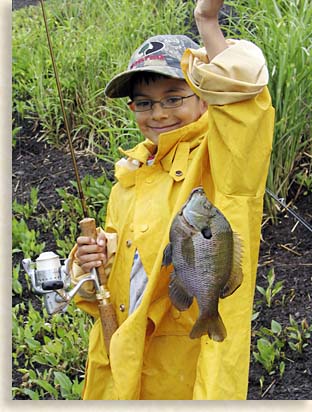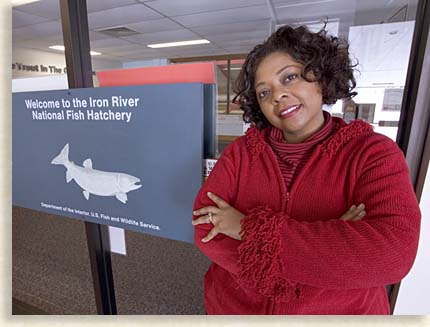Fishing as a Pathway to Nature
by Dr. Mamie Parker, Assistant Director, U.S. Fish & Wildlife Service
Waters long coursed downstream press on me still. The lunges of memorable fish linger in the eddies of my mind. Bright waters beckon this private vice of mine, fishing. And my recollections no matter how old, they always have the tenor of springtime when all things are new. Fishing fixes me to places where I really feel alive. As a young girl and even today, the experience carries a vestige of adventure and wildness – an escape from the artifices of man.
 As I reflect on National Fishing and Boating Week, it pains me that some children don’t experience nature as I have. A recent book by Richard Louv, called Last Child in the Woods: Saving Our Children from Nature-Deficit Disorder, has brought into the national dialogue the condition of today’s children and in particular their poverty of outdoors experiences. Electric cords tether them to the indoors while diabetes and obesity have soared, Louv reports. Increasingly they suffer from ADHD; they’re shuttled to and from pre-planned events, with little chance for spontaneous and creative play. Think about this: you don’t see many children playing outside. It’s a simple observation – but telling. The dearth of youthful experience in nature makes us all the poorer. As I reflect on National Fishing and Boating Week, it pains me that some children don’t experience nature as I have. A recent book by Richard Louv, called Last Child in the Woods: Saving Our Children from Nature-Deficit Disorder, has brought into the national dialogue the condition of today’s children and in particular their poverty of outdoors experiences. Electric cords tether them to the indoors while diabetes and obesity have soared, Louv reports. Increasingly they suffer from ADHD; they’re shuttled to and from pre-planned events, with little chance for spontaneous and creative play. Think about this: you don’t see many children playing outside. It’s a simple observation – but telling. The dearth of youthful experience in nature makes us all the poorer.
Recent scientific research at Cornell University reports what I instinctively know. The Cornell study of 2,000 adults by professors Nancy Wells and Kristi Lekies revealed in the journal, Children, Youth and Environments, that kids that fish and have unstructured time outdoors grow into adults who care more about conservation and the environment.
The U.S. Fish & Wildlife Service will enrich lives with introductions to nature. During National Fishing and Boating Week most of our 70 National Fish Hatcheries across the nation invite thousands of kids and adults to fishing derbies at hatcheries or on waters supported by fish from our hatcheries.
But we’re going to do one better. Congress gave the U.S. Fish & Wildlife Service a charge in the National Fish Hatchery Volunteer Act of 2006, requiring us to create educational guidelines and make use of our hatcheries and fisheries field stations across the nation as outdoor classrooms. In October, Wolf Creek National Fish Hatchery in Kentucky launches the first environmental education curricula with training sessions for hatchery staff, volunteers, and teachers from local schools public and private. Curricula standards will follow national guidelines and relate to those of the local schools, providing the chance for students to up their science literacy and increase their awareness of nature with personal hands-on experience with fish and their habitats. It’s my ardent hope that we touch the lives of youth by planting a germ of an idea that nature matters, that conservation matters.
Our work with the state fish and game agencies and conservation groups matters, not just for conservation, but for people. In July, the once-endangered copper-colored Gila trout in the Southwest will be open to fishing for the first time since the 1950s. Witness our work restoring lake trout in the Great Lakes, at the same time monitoring a novel, but serious fish disease called viral hemorrhagic septicemia. Developments we’ve made in fish nutrition help steelhead on the west coast and Atlantic salmon in the northeast. It falls upon our scientists to marshal the rigorous research necessary to have the Food and Drug Administration approve new aquatic animal drugs for the good of conservation and commerce – and people.
Fishing surely has its values, intrinsic and otherwise. The sport has produced an enduring body of literature. This favorite of American pastimes supports commerce and creates livelihoods  for people; the welfare of people and families depend on quality fishing. National Fish Hatcheries in the Southeast stocking 11 game fish species from American shad to walleye creates 277 private-sector jobs associated with fishing. Based on what a dollar would buy in 2005, those 11 species generated nearly $27 million in total economic output at a cost to the taxpayer of $2 million to raise them. And for youth, fishing is an entrée toward feeding their innate curiosity about nature. This is circuitous, like a lazy oxbow river turns back toward itself: healthy habitats mean healthy fish, healthy economies and healthy people. We need young people in the circle; we need them outdoors where nature will nurture them as they grow – and they’ll grow to nurture nature. Fishing is surely a way there. for people; the welfare of people and families depend on quality fishing. National Fish Hatcheries in the Southeast stocking 11 game fish species from American shad to walleye creates 277 private-sector jobs associated with fishing. Based on what a dollar would buy in 2005, those 11 species generated nearly $27 million in total economic output at a cost to the taxpayer of $2 million to raise them. And for youth, fishing is an entrée toward feeding their innate curiosity about nature. This is circuitous, like a lazy oxbow river turns back toward itself: healthy habitats mean healthy fish, healthy economies and healthy people. We need young people in the circle; we need them outdoors where nature will nurture them as they grow – and they’ll grow to nurture nature. Fishing is surely a way there.
Dr. Parker is the Assistant Director of the US Fish & Wildlife Service in Washington DC, an avid angler, and member of the Arkansas Outdoor Hall of Fame.
Photos were provided by US Fish & Wildlife Service and used by permission, all copyrights reserved. |


 As I reflect on National Fishing and Boating Week, it pains me that some children don’t experience nature as I have. A recent book by Richard Louv, called Last Child in the Woods: Saving Our Children from Nature-Deficit Disorder, has brought into the national dialogue the condition of today’s children and in particular their poverty of outdoors experiences. Electric cords tether them to the indoors while diabetes and obesity have soared, Louv reports. Increasingly they suffer from ADHD; they’re shuttled to and from pre-planned events, with little chance for spontaneous and creative play. Think about this: you don’t see many children playing outside. It’s a simple observation – but telling. The dearth of youthful experience in nature makes us all the poorer.
As I reflect on National Fishing and Boating Week, it pains me that some children don’t experience nature as I have. A recent book by Richard Louv, called Last Child in the Woods: Saving Our Children from Nature-Deficit Disorder, has brought into the national dialogue the condition of today’s children and in particular their poverty of outdoors experiences. Electric cords tether them to the indoors while diabetes and obesity have soared, Louv reports. Increasingly they suffer from ADHD; they’re shuttled to and from pre-planned events, with little chance for spontaneous and creative play. Think about this: you don’t see many children playing outside. It’s a simple observation – but telling. The dearth of youthful experience in nature makes us all the poorer. for people; the welfare of people and families depend on quality fishing. National Fish Hatcheries in the Southeast stocking 11 game fish species from American shad to walleye creates 277 private-sector jobs associated with fishing. Based on what a dollar would buy in 2005, those 11 species generated nearly $27 million in total economic output at a cost to the taxpayer of $2 million to raise them. And for youth, fishing is an entrée toward feeding their innate curiosity about nature. This is circuitous, like a lazy oxbow river turns back toward itself: healthy habitats mean healthy fish, healthy economies and healthy people. We need young people in the circle; we need them outdoors where nature will nurture them as they grow – and they’ll grow to nurture nature. Fishing is surely a way there.
for people; the welfare of people and families depend on quality fishing. National Fish Hatcheries in the Southeast stocking 11 game fish species from American shad to walleye creates 277 private-sector jobs associated with fishing. Based on what a dollar would buy in 2005, those 11 species generated nearly $27 million in total economic output at a cost to the taxpayer of $2 million to raise them. And for youth, fishing is an entrée toward feeding their innate curiosity about nature. This is circuitous, like a lazy oxbow river turns back toward itself: healthy habitats mean healthy fish, healthy economies and healthy people. We need young people in the circle; we need them outdoors where nature will nurture them as they grow – and they’ll grow to nurture nature. Fishing is surely a way there.